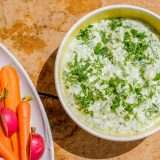The tiny table at which I sit tucked against the back wall of Fidiou 2 is as jammed as the bar itself, Athenians and food overflowing as midnight nears. A trio with castanets and guitar sings rembetiko, folk music melodic and moanful.
We sip shots of rakomelo—a potent ouzo-like liquor called raki warmed and seasoned with honey, cinnamon and cloves. Waiters dart and dodge, bringing more meze, the small-plate dining that defines Greek cuisine.
Mpekri, tender chunks of wine-braised pork. Teeth-chiseling rusks piled with chopped tomatoes, cheese and olives, washed with olive oil. Potatoes, herbal and pungent with parsley and garlic. And three unexpectedly appealing dips—fava, a warm, creamy-tangy split pea puree; tirokafteri, a mash of briny feta and spicy peppers; and tzatziki, a thick mound of yogurt striated with cucumber and dill.
Learning meze—or at least its dishes that would most deliciously translate to the American table—is what brought me to Athens. My teacher would be Argiro Barbarigou, the country’s leading voice on its foodways. But to formulate the lesson plan, first I’d need to eat.
We think of meze as bar food—small bites accompanied by coffee or liquor, often both—which is true. But understanding In Greece, meze and the places it is consumed stretch across the day, starting with breakfast. Which is how I find myself early the next morning at Byzantio, a dimly lit kafenio—or café—where old men sit pressed to the brown walls, sipping sediment-rich coffee and later ouzo, playing cards and nibbling meze.
Again, my table overflows. Fried sardines, anchovies and squid. A salad of crab, potatoes, olives and beets with dill, parsley and lemon. Fried liver dusted with pepper and oregano. And three echoes of the previous night—the yellow split pea puree, the spicy feta dip and a cooling, minty rendition of tzatziki. All doused liberally with olive oil.
The seafood is outrageously good—fat and moist, tender and crisp. The salad fresh yet robust. But it is the dips that draw me.
The fava—which contains no fava beans, but takes its name from the Greek word for yellow split peas—is mellow and creamy like hummus, with a subtle peppery savoriness I can’t quite identify. The tirokafteri is robustly spicy, whipped feta tinged red and flecked with chili. As with creaminess—I can’t suss. And the tzatziki is richer and thicker than any I’ve ever had, with no obvious explanation. I dredge hunks of bread through them. Each offsets another, balancing heat and salt and richness.
Over five days, across the clock and no matter what the meal, the dips are on repeat.
At Iolkos, a restaurant south of Athens and a short toss from the Aegean Sea, the lunchtime drink that accompanies meze is tsipouro, a clear spirit from northern Greece. The restaurant’s barn-like walls are lined with condiments and booze, and the same trio of dips is accompanied by politiki salad—a lemony slaw of cabbage and peppers—and tender, sweet octopus piled with crisply fried arugula. Here, the fava is savory and smooth; the feta is compellingly high-heat, but the tzatziki tames it.
At Mavro Provato, a hipster taverna set in a residential enclave of Athens lined with sour orange trees, crunchy keftedes and a charred eggplant salad accompany a smooth, lightly savory fava, a spicy feta whipped mousse-like and a tzatziki that is a push and pull of punchy garlic and comforting yogurt.
At roadside souvlaki joints, shaved pork rich with garlic, oregano and hot paprika is swaddled in soft pita and doused with creamy tzatziki. And at To Triantafylo Tis Nostimias—or The Rose of Desire—a crowded lunch spot hidden in a shopping plaza, the trio offsets calamari and spicy shrimp fried in the shell.
By the time I work with Argiro Barbarigou—her husband pouring us a crisp local white wine—I’m smitten with fava, tirokafteri and tzatziki. They are peasant foods, eaten abundantly for their simplicity and use of common ingredients. As she teaches, the mysteries reveal themselves. With hummus—which fava so reminds me of—onion is an accompaniment. In fava, it is cooked and pureed in, adding the savoriness I detected. Barbarigou also tops the fava with tomatoes, red onion and capers.
There was also a tang that puzzled me. I’d expected lemon, but there was none. Greeks do love lemon, Barbarigou explained, but as a seasoning, not a go-to acid. When a simple sharpness is desired to brighten other flavors, the choice is usually red wine vinegar. It is used liberally in fava.
The greatest revelation comes with the tzatziki. Barbarigou stirs Greek yogurt with garlic, cucumber, dill, mint and—again no lemon—red wine vinegar. The result is thick and rich. Turns out the secret is how she treats the cucumber.
When I’ve made tzatziki, I’ve always laboriously peeled, then halved the cucumbers before scraping out the seeds, then mincing the flesh. Removing the seeds reduces the excess liquid the cucumber bleeds into the yogurt, thinning the consistency and watering down the flavor. But my tzatziki always ended up watery anyway.
Barbarigou’s technique was better, easier and faster. First, she skips peeling; she prefers the texture the skin adds to the finished dish. Second, instead of seeding and dicing, she simply grates the cucumber on a box grater, shaving each side down to the seedy core, which she discards. Next, she salts the shreds, drawing out moisture, then drains them in a colander. Finally, she squeezes them so they add texture and freshness without diluting the yogurt.
Perhaps most satisfying of all? All three dips required little translating. The flavors are simple but layered. We leave it to you to decide whether they require a shot of ouzo.






